Employment in Oklahoma’s oil and gas industry began falling late last year and through July 2015 had declined more than 14 percent, a loss of more than 9,000 jobs. As the difficulties in oil spilled over to related sectors—including some types of manufacturing, transportation and business services—overall Oklahoma employment also slowed, and by July was down nearly half a percent from its February peak. Oil prices fell to 2015 lows in August, raising more concerns about the economy. Several key Oklahoma industries, however, are largely unaffected by trends in oil prices while others are only partially dependent on activity in oil and gas. This edition of The Oklahoma Economist reviews the outlook for the energy sector and examines the performance of the state’s other important industries.
Low oil prices likely to remain a drag on state economy
Oil prices increased nearly 40 percent from March to June before starting to fall in July. In late August, domestic prices briefly dropped below $40 a barrel (Chart 1). Intermediate-term futures prices and government oil price forecasts were also revised down over the summer as the world’s oil supply continued to increase more than expected. In particular, supply from Saudi Arabia and Iraq rose sharply while it did not slow as much as anticipated elsewhere. As such, the U.S. Energy Information Administration (EIA) now expects the world’s oil supply at year-end to exceed demand by more than 1.5 million barrels a day, up from an estimated difference in April of less than 500,000 barrels a day.
Given these developments, both current and expected oil prices are now well below levels firms say they need to ramp up activity—or remain profitable. Respondents to the Federal Reserve Bank of Kansas City’s latest quarterly energy survey in late June said oil prices would need to average $73 a barrel to trigger a significant increase in drilling (Chart 2). At the time, they were not expecting to see this price before 2017—and that was before the recent downturn in prices. In March, firms had said they needed an average of $62 a barrel to be profitable, a higher price than year-end 2016 futures prices or late-August EIA forecasts. This suggests the energy sector is not likely to provide much of a near-term boost to the Oklahoma economy and could continue to be a drag on growth. With oil and gas likely remaining on the sidelines, Oklahoma will need other industries to help drive economic growth.
Chart 1: WTI Oil Prices
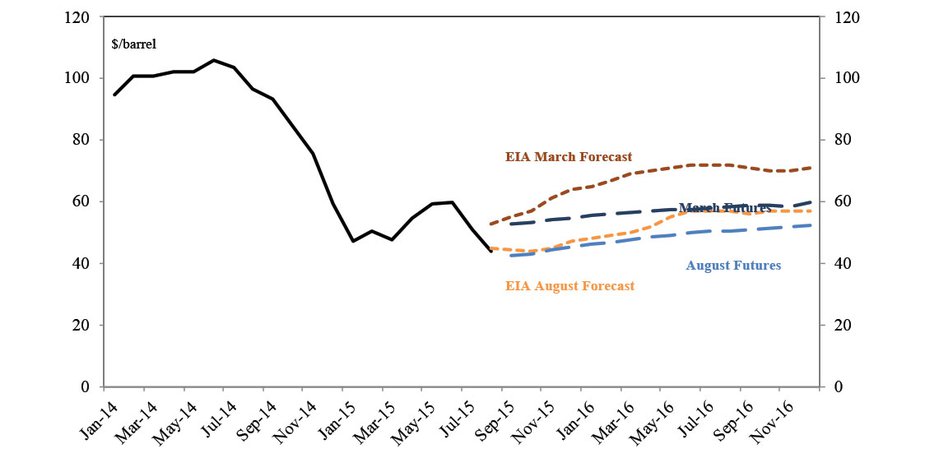
Sources: EIA, Reuters
Chart 2: Tenth Fed District Energy Survey
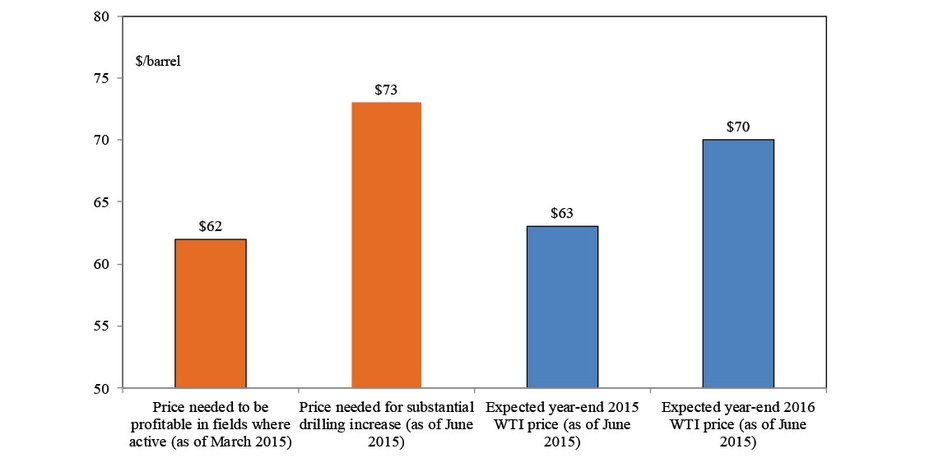
Sources: FRBKC Energy Surveys
Important and unique sectors in Oklahoma
A variety of measures show the oil and gas sector is the most important and unique industry in Oklahoma. However, several sectors largely unrelated to, or only partly dependent on oil and gas already are important or quickly becoming so.
A straightforward way to determine an area’s key industries is to look at their absolute size. By this measure, the largest of the 86 detailed Oklahoma industries for which the U.S. Bureau of Economic Analysis provides income data is oil and gas extraction (9.9 percent of total worker earnings in the state) (Table 1). Most of the other largest industries in the state service the oil and gas industry or rely on tax revenues from it, including professional and administrative services, specialty trades and state and local government. Exceptions include healthcare industries (including hospitals and ambulatory—or outpatient—care) and the federal government (including defense-related civilian employment).
Table 1: 10 Largest Oklahoma Industries, 2013
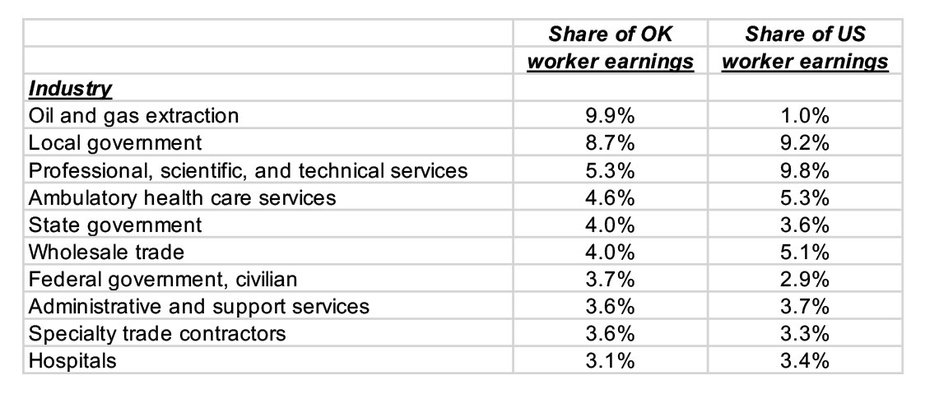
Note: Industries denoted in blue are part of the oil and gas sector
Source: U.S. Bureau of Economic Analysis
Another way to determine an area’s most important industries is to compare each industry’s relative shares of local and national economic activity. The result of this comparison is a location quotient (LQ). Looking at detailed industries across Oklahoma with the highest LQs, most are in or closely tied to the oil and gas industry (Table 2). At the state level, oil and gas extraction and pipeline transportation both have LQs of 9.8, meaning each is nearly 10 times more important to Oklahoma than the nation. Support activities for mining (in Oklahoma mining consists almost completely of oil and gas activity) also has a high LQ, as does petroleum and coal products manufacturing (including primarily refining in Oklahoma). Together, these four detailed industries make up the state’s broader oil and gas sector (denoted in blue in the tables) and account for about 16 percent of total Oklahoma worker earnings. Machinery manufacturing, which produces equipment for energy and other industries, is also quite important in the state. A few industries not related to energy in more specific parts of Oklahoma also have high LQs. In the Oklahoma City metropolitan area, the federal government has a sizable presence. In the Tulsa metro area, fabricated metal manufacturing is important, although some of its production is for the oil and gas sector. In the Lawton metro area, military-related activity dominates. In non-metro areas of the state, agriculture is significant.
Table 2: Industries over twice as important in Oklahoma as U.S., 2013*
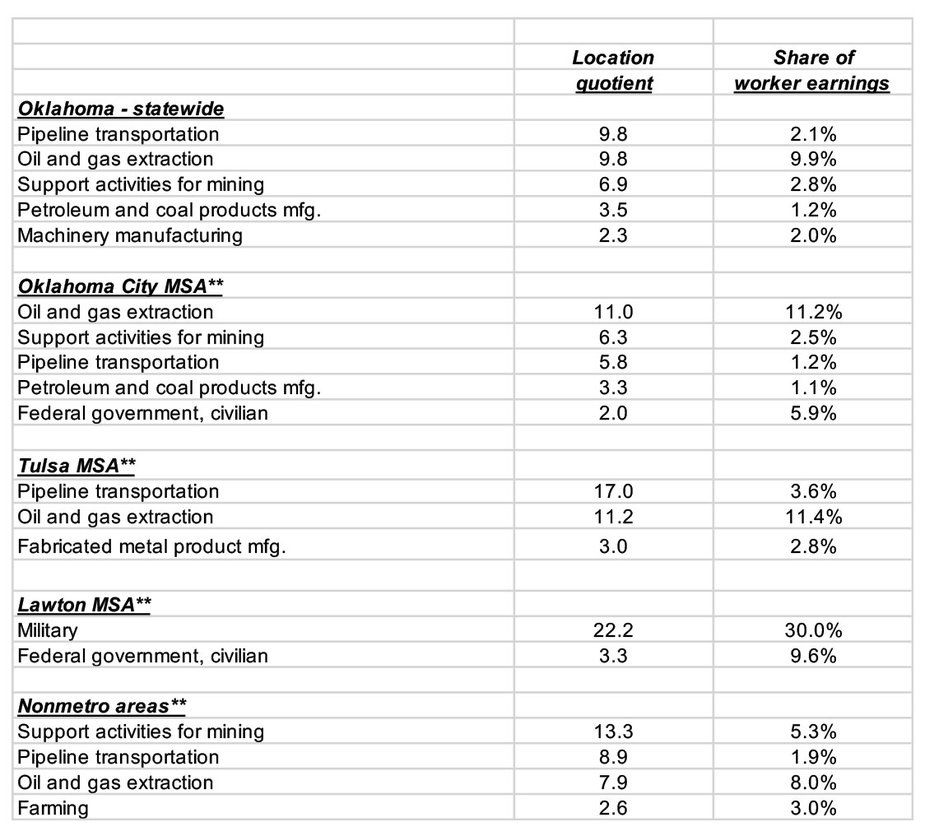
* Among industries with at least 1 percent of total Oklahoma worker earnings
** Note: data not avaliable for all industries for all metropolitan and nonmetropolitan
Note: Industries denoted in blue are part of the oil and gas sector
Source: U.S. Bureau of Economic Analysis
Another way to determine an area’s most important industries is to look at which have grown fastest over time, both overall and relative to the nation. In Oklahoma, most of the fastest-growing industries from 2003 to 2013 were tied directly or indirectly to the energy sector (Table 3). This likely would include construction and real estate growth associated with building commercial structures and pipelines for a rapidly growing oil and gas industry, as well as houses for that industry’s workers. However, two of the state’s 10 fastest-growing industries appear mostly unrelated to oil and gas and grew more than twice as fast in Oklahoma as in the nation. These industries are other transportation equipment manufacturing (primarily aerospace in Oklahoma) and arts, entertainment, and recreation (including, among other things, spectator sports, museums and casinos).
Table 3: 10 Fastest Growing Oklahoma Industries, 2003-2013
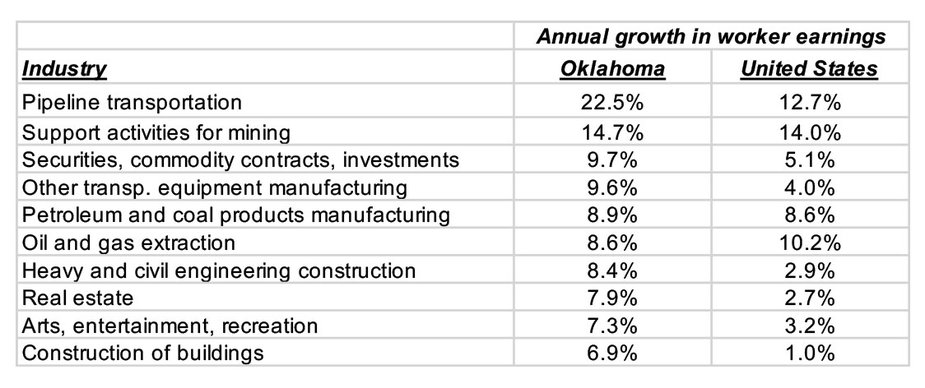
* Industries aggregated up to at least 0.5 percent of total Oklahoma worker earnings
Note: Industries denoted in blue are part of the oil and gas sector
Source: U.S. Bureau of Economic Analysis
Based on these three methods, the following industries in Oklahoma appear to be both important and largely unrelated to oil and gas: agriculture; aerospace; hospitals and outpatient healthcare; arts, entertainment and recreation; and federal government, including military. Together, these industries account for about 16 percent of Oklahoma workers’ earnings, similar to the share in the primary oil and gas industries identified earlier (oil and gas extraction; support activities for mining; pipeline transportation; and petroleum and coal products manufacturing).
Another set of industries also appears to be important in the state but is likely to be at least somewhat dependent on the oil and gas sector. These industries include machinery and fabricated metal manufacturing, construction and real estate, wholesale trade, professional services and administrative services and state and local government. These industries account for more than 30 percent of Oklahoma workers’ earnings, twice as much as oil and gas directly.
Performance of other important Oklahoma industries mixed
Many of the economically important Oklahoma industries not related to oil and gas have weathered the decline in oil prices; some have grown solidly. Others, however, have shed jobs. These industries overall have not added as many jobs as the energy sector has lost.
The agriculture industry in Oklahoma in the last year has performed well and better than nearby states. The Kansas City Fed’s latest quarterly Survey of Agricultural Credit Conditions showed farm income in Oklahoma continued to increase modestly in the second quarter of 2015 even as it declined further in the seven-state Tenth District as a whole (Chart 3). A key reason is that livestock is more important in Oklahoma than in other states in the region (compared with crops), and cattle prices have remained high relative to crop prices. Quickly easing drought conditions are also generally a positive effect for the sector.
Chart 3: Farm Income Indexes
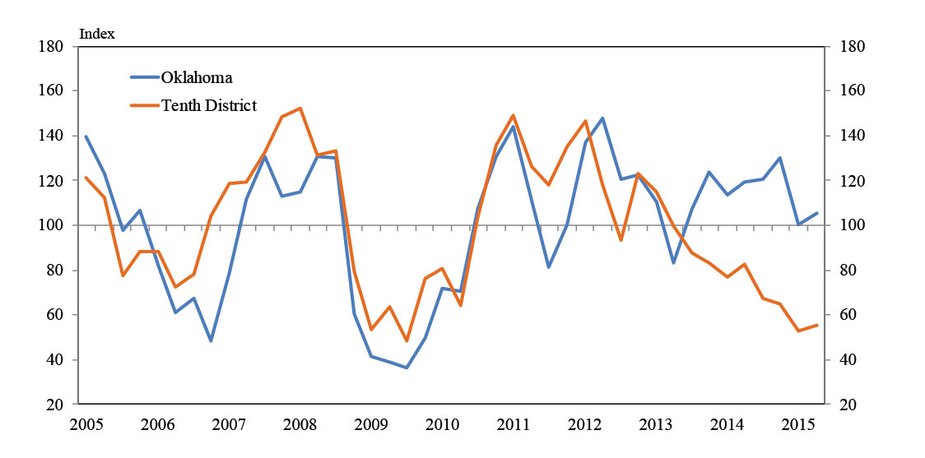
Source: FBRKC Agricultural Credit Survey
For other key Oklahoma sectors, the timeliest indicator of recent performance is employment, and here the results are mixed. Among industries unrelated to oil and gas, the healthcare and entertainment industries have had solid job growth this year (Chart 4). However, employment in the aerospace product and parts manufacturing sector has been flat in 2015, while the federal government has seen a slight reduction in employment. Among industries with some tie to oil and gas, most have seen flat or declining employment this year (Chart 5). Exceptions include construction and local government (including Native American tribal governments), which have posted solid jobs gains.
Chart 4: Jobs in Key Oklahoma Unrelated to Oil & Gas
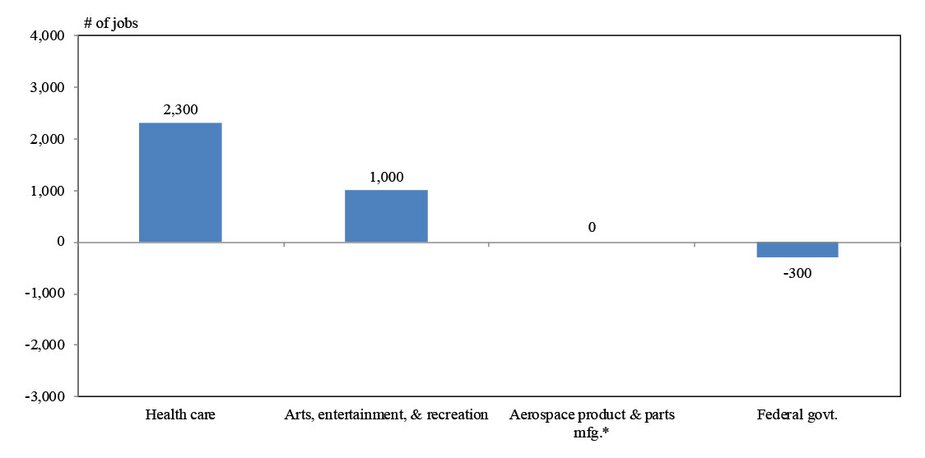
Source: U.S. Bureau of Labor Statistics
Chart 5: Jobs in Key Oklahoma Industries with Some Tie to Oil & Gas
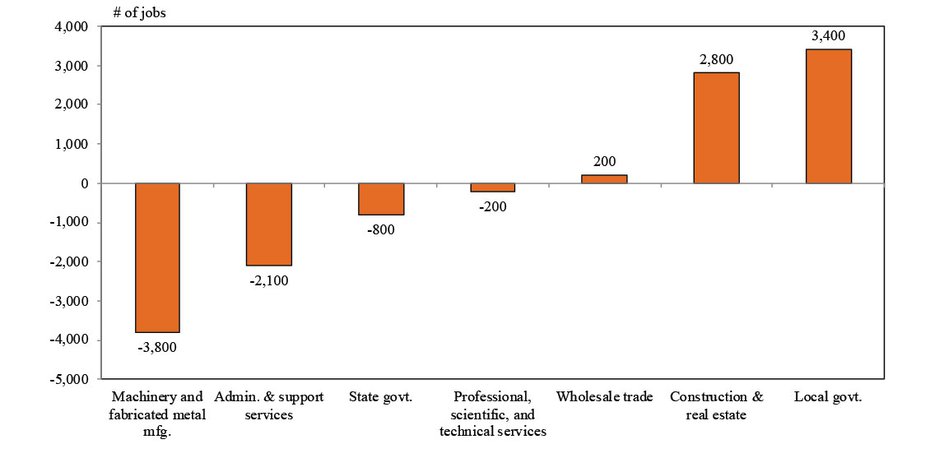
Source: U.S. Bureau of Labor Statistics
Conclusion
Another decline in oil prices has dampened the near-term outlook for the state’s oil and gas sector and focused attention on other sectors that may be capable of driving state economic growth. Some of these other important Oklahoma sectors continue to expand in 2015, such as healthcare, entertainment and construction. Meanwhile, others have been flat or down. However, net jobs added in these other important Oklahoma sectors have not offset losses in the energy sector. As such, if the energy sector remains flat or contracts further in coming quarters, these other sectors will need to increase their pace of growth for Oklahoma’s economy to post solid economic gains.
